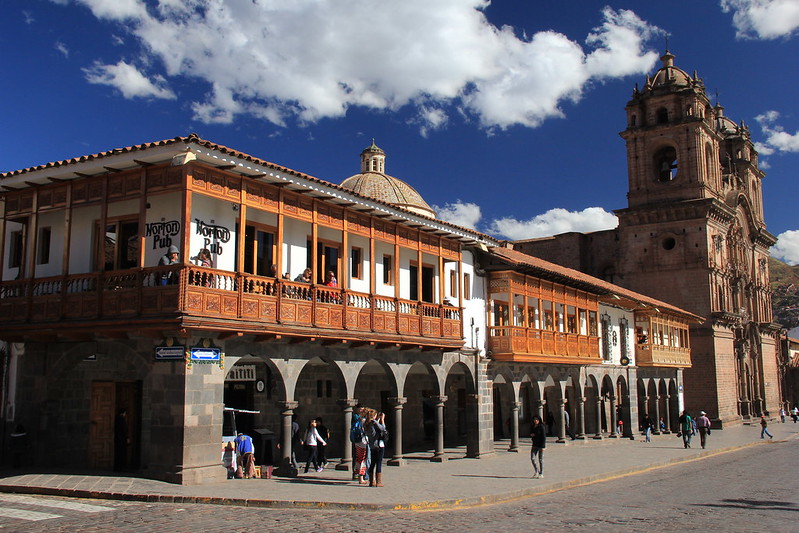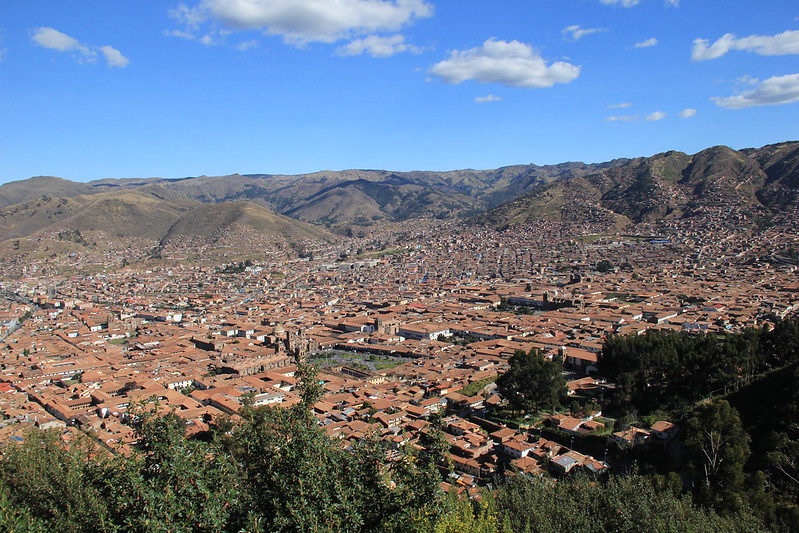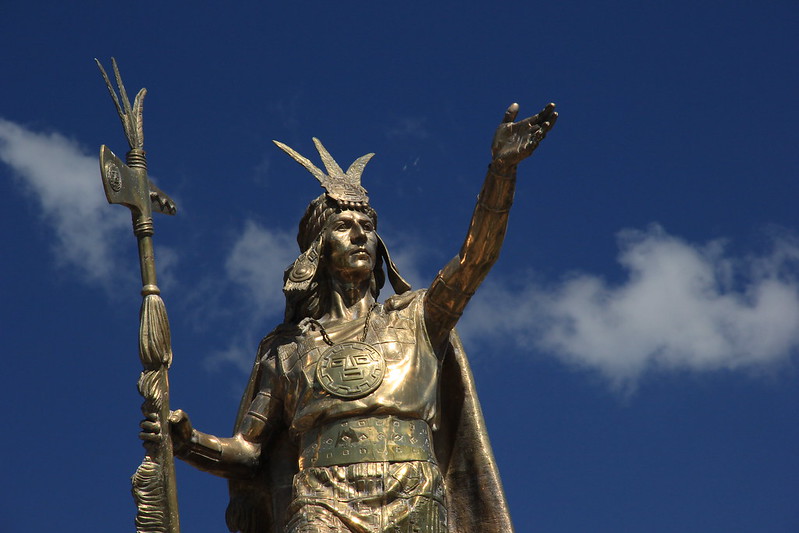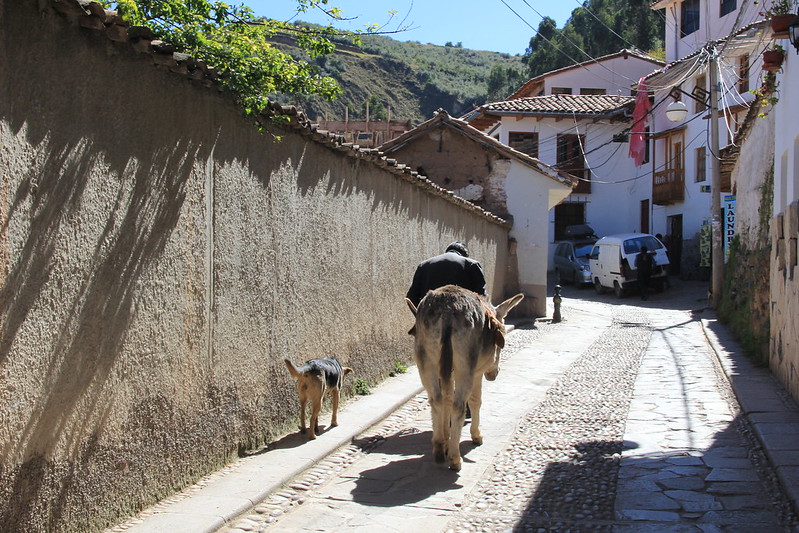Cusco is a 14-16 hour journey along bad country roads from Ayacucho, and seeing as though it’s not one we wanted to make overnight as a result of the warning in our guidebook,
“be advised that robberies occasionally occur on the night bus; travelling during the day is recommended”
we had no choice but to break up our journey with an overnight stop in either Andahuaylas or Abancay. We chose Abancay simply because it was closer to Cusco – by 135 kilometres.
However, getting to Abancay wasn’t going to be quite as easy as we’d anticipated…
Standard buses only left Ayacucho once each day – at 8pm. Catching said bus would involve travelling at night and arriving into our destination at around 2 or 3am. If we took that option, it would mean turning a blind eye to the aforementioned caution about travelling by bus at night. It would also mean wandering the streets of an unfamiliar city at a time of night that most people are in bed, and those that aren’t are probably the kind with whom you want to avoid a close encounter when you have expensive camera equipment and a laptop about your person. Not to mention the danger to ourselves.
Plan B was to take a minibus as far as Abancay. Not quite as cheap as the standard bus but cheaper than a colectivo (shared taxi). Minibuses normally leave Ayacucho at 7:30am, 9:30am, 12:30pm, 2pm, and 8pm.
But the day we needed to travel was not a normal day.
Apparently there were protests happening around the city (my poor Spanish would not stretch to understanding what kind of protests these were and exactly how this would impact upon our journey), so the earliest minibus would not be leaving until 12:30, and it’s an 8-9 hour run to Abancay. Not ideal, but the only option we had.
Yes, the minibus did leave the depot on time but it was well over an hour later when we finally fled the boundaries of the city. We were unable to take the ‘usual’ exit route as a result of the aftermath of the protests (roads completely blocked by rubble or strategically-placed boulders) and as our driver was unfamiliar with the alternative route out of the city, he kept stopping to take directions over the telephone.
Stu and I had bagged the front seats, which is often a bit of a bonus when travelling by minibus because they generally offer better visibility, they’re not quite as claustrophobic, and there are usually seat belts. However I spent a large part of the journey intermittently nudging the driver on one side of me in order to keep him awake, whilst Stu was busy snoring beside me on the other.
It was already dark when we pulled into Andahuaylas, where we discovered that the bus we were on didn’t actually go any further, and if we wanted to continue on to Abancay, we’d have to change buses. We managed this without too much trouble, but we were sat in the new minibus for about an hour before we moved anywhere. By this time, we were getting pretty hungry (note to self: pack some emergency cereal bars for the next trip) so we bought a huge bag of salted popcorn from one of the street vendors beside the bus, and proceeded to nibble our way through it during our 3-hour journey on to Abancay.
We finally pulled into Abancay just before 10pm, caught a taxi to the only hotel listing in our guidebook, rejoiced when the kind gentleman advised us that yes he did have a room available, and crashed out in the comfortable double bed not long afterwards.
Tomorrow was another day.
Tomorrow we would finally arrive into Cusco, the historical capital of Peru, and the most revered city in the country. When I was back in England earlier this year, perusing travel blogs and marvelling at photographs in magazines or on Pinterest, Cusco and the Inca Trail were going to be the highlights of my trip. It was here I was looking forward to exploring more than anywhere else (with the possible exception of Iquitos and the Amazon jungle).
Now I don’t know what they put in my breakfast at the hotel in Abancay, but within about half an hour of eating it I wasn’t feeling right. I was lightheaded and nauseous and just wanted to lie down. I spent the entire 5-hour bus journey to Cusco with my head out the window, contemplating whether it would be better to be sick in my hat (I quite liked the hat; it had been given to me by a friend I’d met on the road) or down the side of the coach, and whether the wind was actually strong enough to blow the vomit back into my face if I attempted the latter.
It was the longest 5-hour bus journey I’ve ever taken.
But fortunately I arrived into Cusco with the contents of my stomach still intact. It felt so good to be outside, breathing some fresh(er) air back into my lungs – even though there’s actually less oxygen in the air up here; Cusco stands at 3326 metres above sea level.
When you leave Cusco’s bus station, the city’s charms are not immediately apparent. You pass a lot of poverty – ramshackle buildings and market stalls over-spilling on to the busy, traffic-filled streets. At first it looks like any other city – dirty, overcrowded, and badly maintained – but as we drew closer to the district of San Pedro (where our hostel was located), everything shifted.
There were spacious plazas, grand, well-preserved buildings, and quaint, cobbled streets. It was starting to look exactly like the place I’d dreamed it would be.
Even though we’d been lucky enough to find one of the nicest hostels in the whole of Peru, we couldn’t wait to start exploring the city beyond its four walls.
So, having grabbed a couple of cups of complimentary coca tea (my new addiction since first sampling it in Huaraz; it tastes similar to green tea but a lot smoother), we headed up Calle Ceniza in the direction of the city’s Plaza de Armas, the beating heart of Cusco’s historical core.
The city is a a wonderful mix of Inca and Spanish influences. Dominated as early as 700-800AD by the Killiki (who built temple structures from the hard local diorite and andesite stones, some of which still survive today), Cusco was the capital of the Inca empire for over 300 years before being invaded by the Spanish conquistadors in 1532.
What I loved about Cusco is that in spite of the 21st century hustle, the elegant boutiques, high-end restaurants, massage hawkers, and traditionally dressed locals (usually with a baby llama in hand) hoping to pose for photographs in exchange for a few soles, its tradition and beauty still shines through.
Modern-day cafes and shops (which include fast-food giants McDonalds and KFC, and outdoor stores selling knock-off North Face fleeces) are hidden behind the facade of countless beautiful colonial buildings, with decorative balconies and ancient stone arches.
What’s more, there are literally hundreds of tranquil little alleyways and narrow cobbled streets to wander down, which in my opinion is the best way to spend your time in the imperial city.
Even though Cusco sees 2 million tourists every year, it’s a lot easier than you think to escape the crowds. Meandering my way through the maze of back streets in the hilly, bohemian neighbourhood of San Blas, it was very easy to forget that I was actually in the seventh largest city in Peru.
We finished our afternoon of exploring with a meal at the amazing Greens Organic (we got 10% off their (not so cheap) prices by simply being guests at Mama Simona). Even though I still wasn’t feeling 100%, I couldn’t possibly turn down their tantalising selection of Peruvian fusion dishes, all cooked with organic products which are grown on their very own farm.
Aside from paying our remaining Inca Trail balance and attending a welcome meeting at the Peru Treks office, we had another 3 days to further discover what this captivating city had to offer, and it was 3 days I was very much looking forward to.
Have you visited Cusco? What were your favourite bits?
If you like this article, please follow along on Facebook, Twitter, or Google+ or you can look me up on Instagram or Pinterest too!
This is part of the #SundayTraveler link-up, hosted by Chasing The Donkey, Pack Me To, A Southern Gypsy, The Fairytale Traveler, and Ice Cream and Permafrost.













No Comments